What are the causes of climate change and how is it affecting the world?
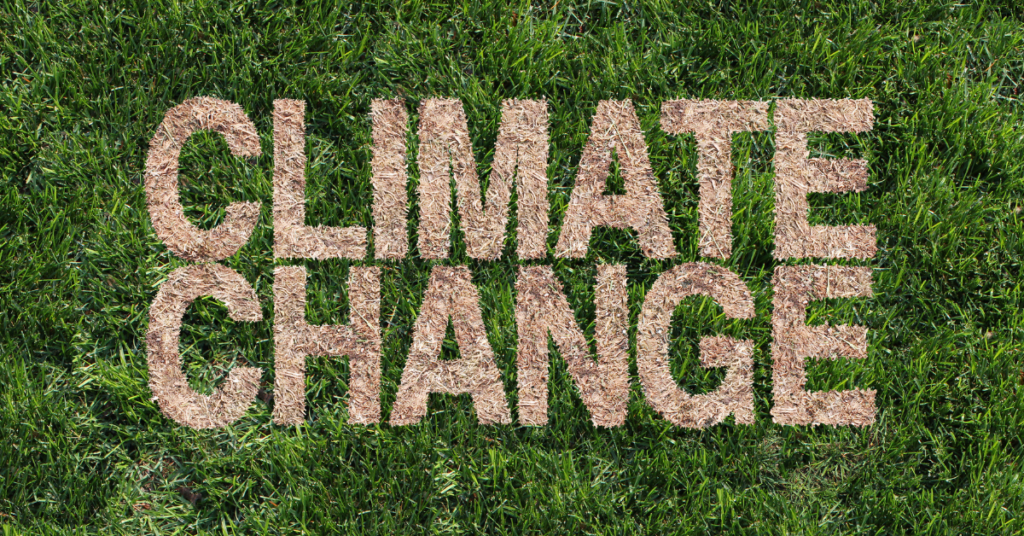
This article does not feature catastrophic scenarios from science fiction films. Instead, you will find solid scientific data and concrete, real-life examples, as well as answers to the most common questions from sceptics. We will explain why the climate is changing, who is responsible, and what can be done about it. We are not activists, but ordinary people who listen to science.
Is human activity the cause of the climate catastrophe?
Climate change is neither a hypothesis nor a conspiracy theory, nor is it a ‘natural cycle’, as sceptics suggest. It is a phenomenon confirmed by hard data, hundreds of scientific studies, and decades of observations from around the world.
The Earth’s atmosphere is warming at an unprecedented rate. Glaciers are disappearing, sea levels are rising, and extreme weather events are becoming the new normal. These changes are not happening without cause. These changes are the direct result of specific human activities, primarily the emission of greenhouse gases from the combustion of fossil fuels, deforestation and large-scale agriculture.
Today, there is no serious scientific body that questions the anthropogenic sources of global warming. The scientific consensus is overwhelming: we are changing the climate.
What is causing climate change?
The unprecedented climate change that we are witnessing worldwide is unequivocally caused by human activity, primarily in the form of greenhouse gas emissions.
According to the IPCC Sixth Report (IPCC (AR6):
„It is unequivocal that human influence has led to a warming of the atmosphere, ocean and land.”
The most important anthropogenic (i.e. human-derived) drivers of climate change are:
- Carbon dioxide (CO₂) emissions from coal, oil and gas combustion.
- Emissions of methane (CH₄) and nitrous oxide (N₂O) mainly from agriculture and industry.
- Deforestation, which reduces the planet’s ability to absorb CO₂.
- Industrial pollutants, including fluorinated greenhouse gases.
Natural factors such as solar activity and volcanoes have had a negligible impact on the observed global warming – in contrast to the dominant human influence.
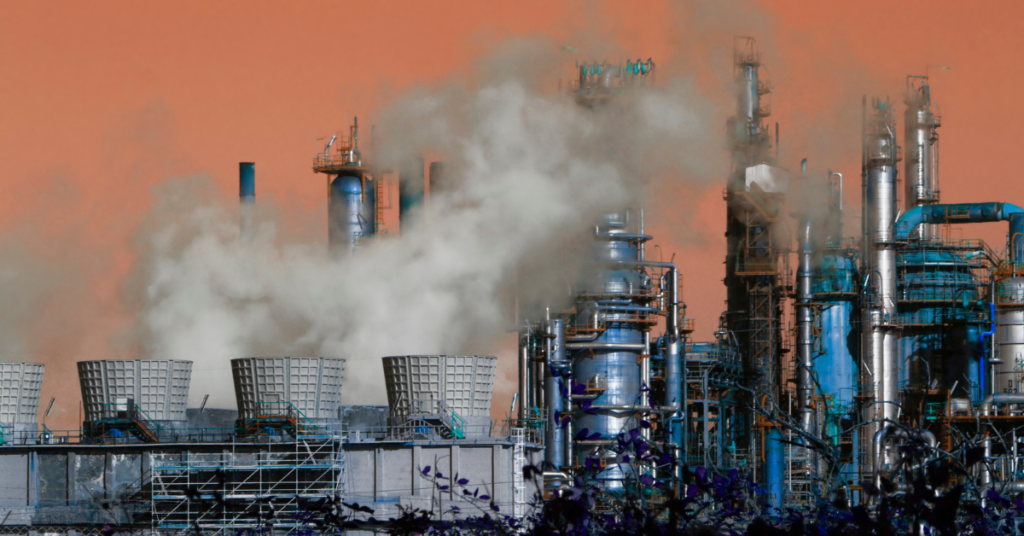
Since when have we been studying the warming of the Earth’s climate?
The study of the Earth’s climate in the context of global warming has mainly focused on the period since the beginning of the industrial revolution, the mid-19th century. This is when we started to systematically burn fossil fuels on a large scale, releasing increasing amounts of carbon dioxide (CO₂) into the atmosphere.
We measure the increase in the Earth’s average temperature against the pre-industrial era (c. 1850-1900) – considered the baseline when human activity had not yet had a significant impact on the climate. Since then, the global average temperature has increased – and it is this increase that is the key evidence of anthropogenic climate change.
Global average temperature – how much should it be?
In the Paris Agreement, adopted at COP21 in December 2015, countries pledged to limit the increase in global average temperature to ‘well below 2 °C’ above pre-industrial levels, while making an effort to make the target even more ambitious – not to exceed 1.5 °C.
This lower limit stems from concerns that exceeding 2 °C could cause so-called “irreversible” climate change – such as loss of the Arctic ice sheet, sustained sea-level rise or mass extinction of species . Therefore, 1.5 °C is the safety limit – the closer we stay to this value, the less severe the consequences will be.
Today, however, we already know that 2024 was the first year on record in which the average temperature exceeded the 1.5 °C warming threshold. Scientists are keen to ensure that this level does not persist permanently – in which case it will not be possible to lower the temperature or reverse the changes, for which it is not too late now.
Global warming – how has the planet’s temperature been rising?
A sharp acceleration in the rise of the planet’s surface temperature was recorded after 1970. The decade 2013-2023 was the warmest ever measured, and 2024 broke all previous global heat records. Most noticeable for us are the heat waves haunting European countries, e.g. Spain (45°C), or the UK (40°C).
Particularly acute are the high temperatures in large cities, which become almost unbearable in summer. Another consequence of the warming of the earth is record measurements in temperate and subpolar regions, e.g. 30°C in Northern Canada, which used to simply not happen.
Temperatures are not rising evenly across the globe. The Arctic is warming the fastest. Greenland is losing more than 250 billion tonnes of ice a year for the same reason. NASA satellites provide us with real-time information on this. Glaciers around the world are melting at an alarming rate. Antarctica alone is losing 150 billion tonnes of ice every year.
The massive loss of ice is causing sea levels to rise faster and faster, and if current trends continue, by the end of the century ocean levels could rise by as much as 1 metre, threatening the existence of cities such as Jakarta, Miami, Venice and many Pacific islands.
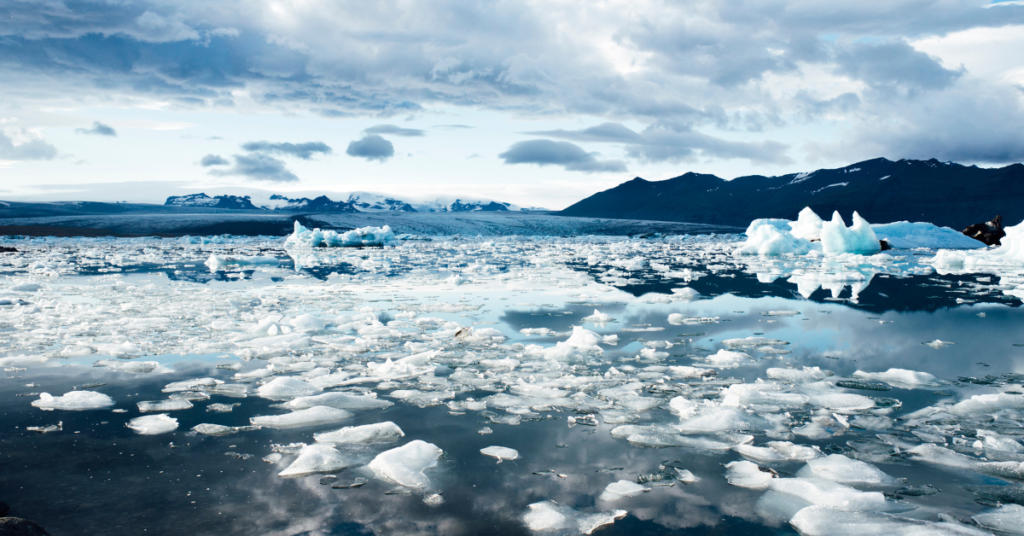
As a result of global warming, extreme weather events are becoming the norm. These are no longer ‘vagaries of the weather’ – this is the new climate. A warmer atmosphere traps more energy and moisture, which fuels tragedies such as:
- forest fires Canada, 2023 – more than 17 million hectares burned, an all-time record;
- floods: Pakistan (2022), Libya (2023) – tens of thousands of victims;
- droughts: in 2022 as much as 60% of the EU area was at risk of severe water scarcity;
- cyclones: warmer oceans mean stronger hurricanes – class 5 phenomena are occurring more frequently.
For years, scientists have been creating so-called climate models that simulate temperature changes based on different scenarios. When the models only considered natural factors (e.g. changes in solar activity, volcanoes), they were unable to reproduce the current warming.
Only when anthropogenic factors are added – such as CO₂ emissions, methane, deforestation – do the simulations accurately match reality. Only models that take human activity into account explain the current changes. Why? There is no clearer indicator of anthropogenic impact than the concentration of carbon dioxide (CO₂).
Before the industrial era, it was around 280 ppm (particles per million). In May 2024, it exceeded 426 ppm – and is still rising. It is significant that such values have not occurred on Earth for about 2 million years. At that time, sea levels were several metres higher and the Arctic was devoid of ice. What is the difference? Back then, changes in carbon dioxide concentrations stretched over thousands of years, whereas now it happens in one century.
Who is responsible for the greenhouse effect and climate change?
The main cause of the increase in greenhouse gas (GHG) concentrations is the burning of coal, oil and natural gas. We emit billions of tonnes of CO₂ per year into the atmosphere, and this amount has been increasing steadily not for thousands of years, but for less than 200 years.
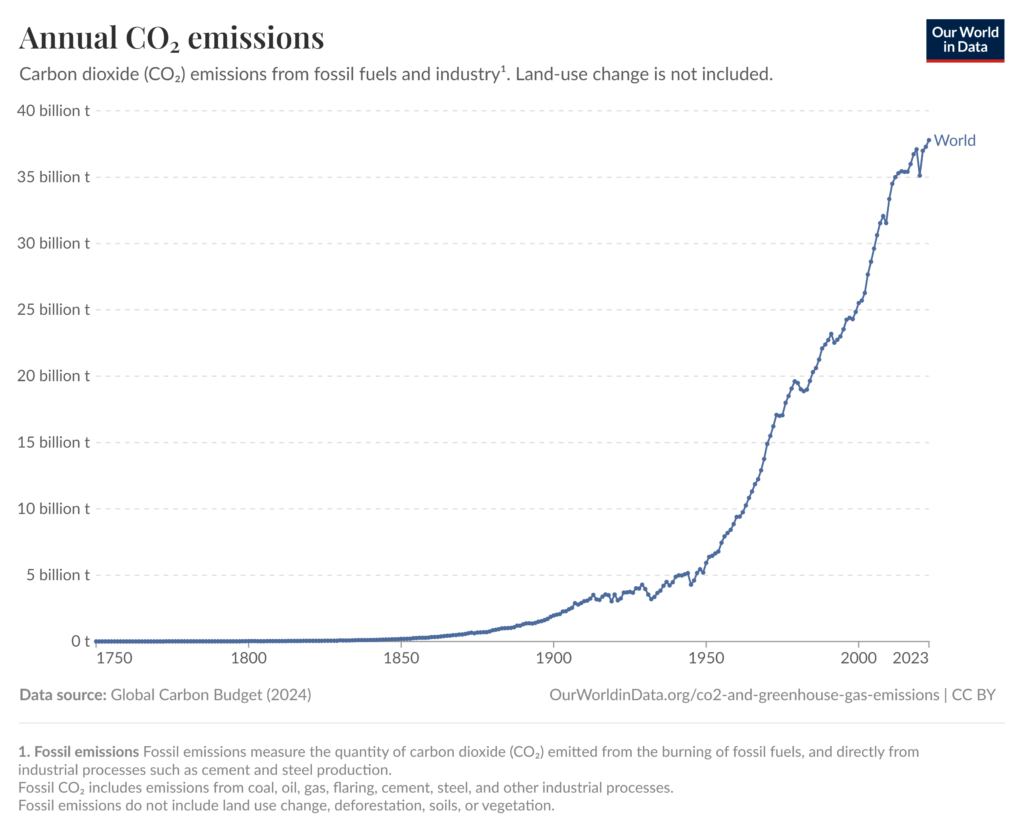
An analysis of the available data highlights the leap in growth after 1950, when the so-called Great Acceleration occurred as a result of industrial energy production, mass transport and large-scale urbanisation.
In addition to increasing CO₂ emissions, humans are leading to a decrease in the absorption of CO₂ by the planet with their activities. This is due to intensive deforestation. Forests are a natural filter for our atmosphere. By cutting them down, additional carbon dioxide is emitted from the decomposition of organic matter. The largest tropical forest in the world, the Amazon, has been emitting more CO₂ than it absorbs for several years. By contrast, peatlands and rainforests in Southeast Asia are being burned for palm oil crops.
Agriculture, in addition to the “forestry push”, determines its impact on the climate through methane emissions. Methane (CH₄) is a little-visible but very dangerous greenhouse gas. For 20 years it has had a greenhouse effect more than 80 times stronger than CO₂. Animal husbandry is responsible for the largest, but not the only, share of emissions. Methane also comes from fertilisers, manure fermentation and rice cultivation.
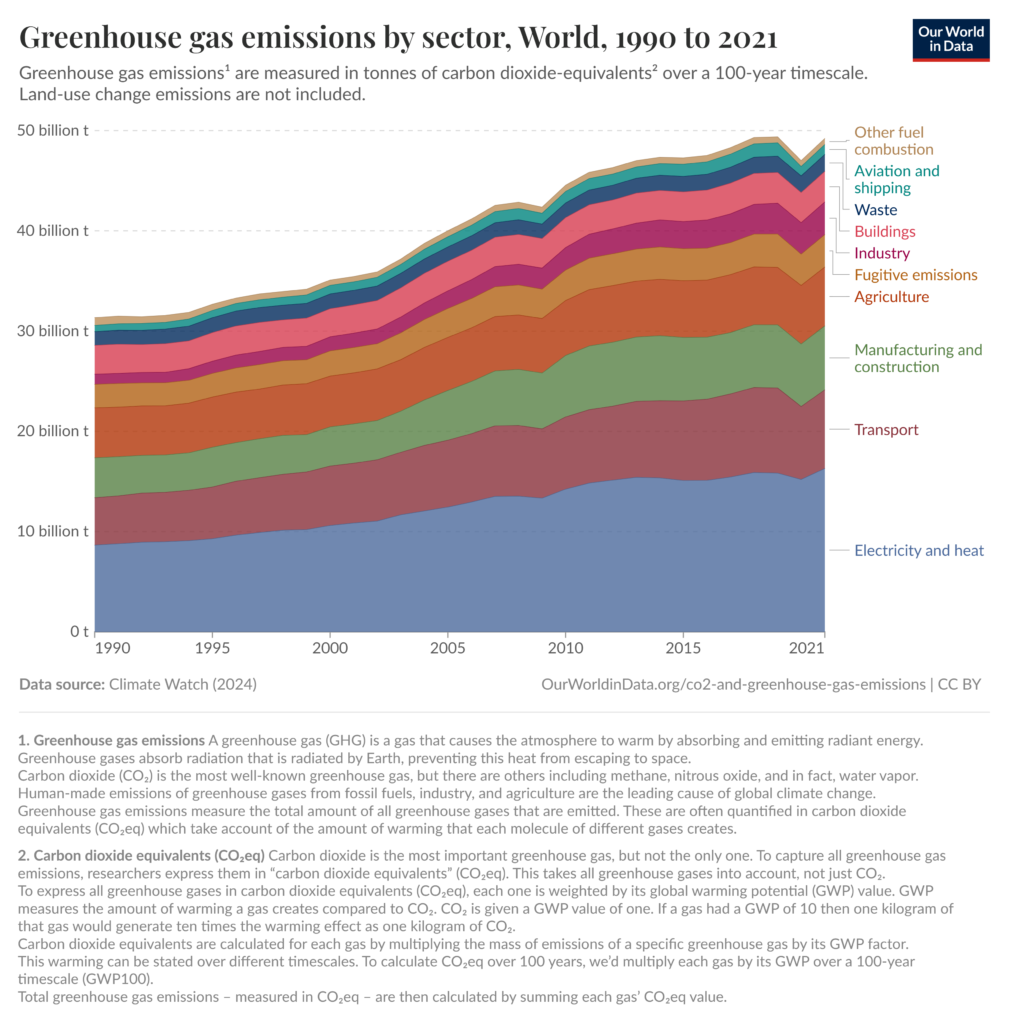
Greenhouse gas emissions are also driven by transport and heavy industry. These are very difficult sectors to decarbonise. They require investment in innovation e.g. electrification, hydrogen fuel, CSS. Cars, ships and aircraft account for about 16% of global GHG emissions. In developed countries, these emissions are even higher. Heavy industry (steel, cement, chemicals) is a huge source of emissions not only of carbon dioxide, but also of other process gases that are difficult to capture in statistics.
How does climate change affect your business?
Or is man not to blame after all? Some denialists claim that the sun and planetary cycles are behind climate change. Unfortunately, the scientific data is inexorable. Solar activity has not only not increased in recent decades, it has actually decreased. Volcanic activity does not explain climate warming either. The aerosol effect causes eruptions to cool the planet. If natural factors were the cause, the climate should be cooling slightly, not warming.
In conclusion, climate change is not only real, but also unequivocally man-made. Emissions of CO₂, methane and other greenhouse gases come from our economy: energy production, agriculture, transport and industry. The conclusions are quite grim, but they can also be looked at from another perspective. If humans are causing climate change by their activities, they can also stop it by their activities.
What could be the effects of climate change on humans?
The human impacts of climate change are diverse and can have serious consequences in many aspects of social, economic and health life.
Health effects of climate change
These are already being observed. The already mentioned heat waves increase the risk of death, especially among the elderly and children. A warmer climate also favours the spread of vector-borne diseases such as malaria, dengue fever and the Zika virus. Higher temperatures are also causing air quality problems. Respiratory diseases are becoming more common. The WHO estimates that air pollution kills more than 7 million people worldwide each year, which is more than cigarettes.
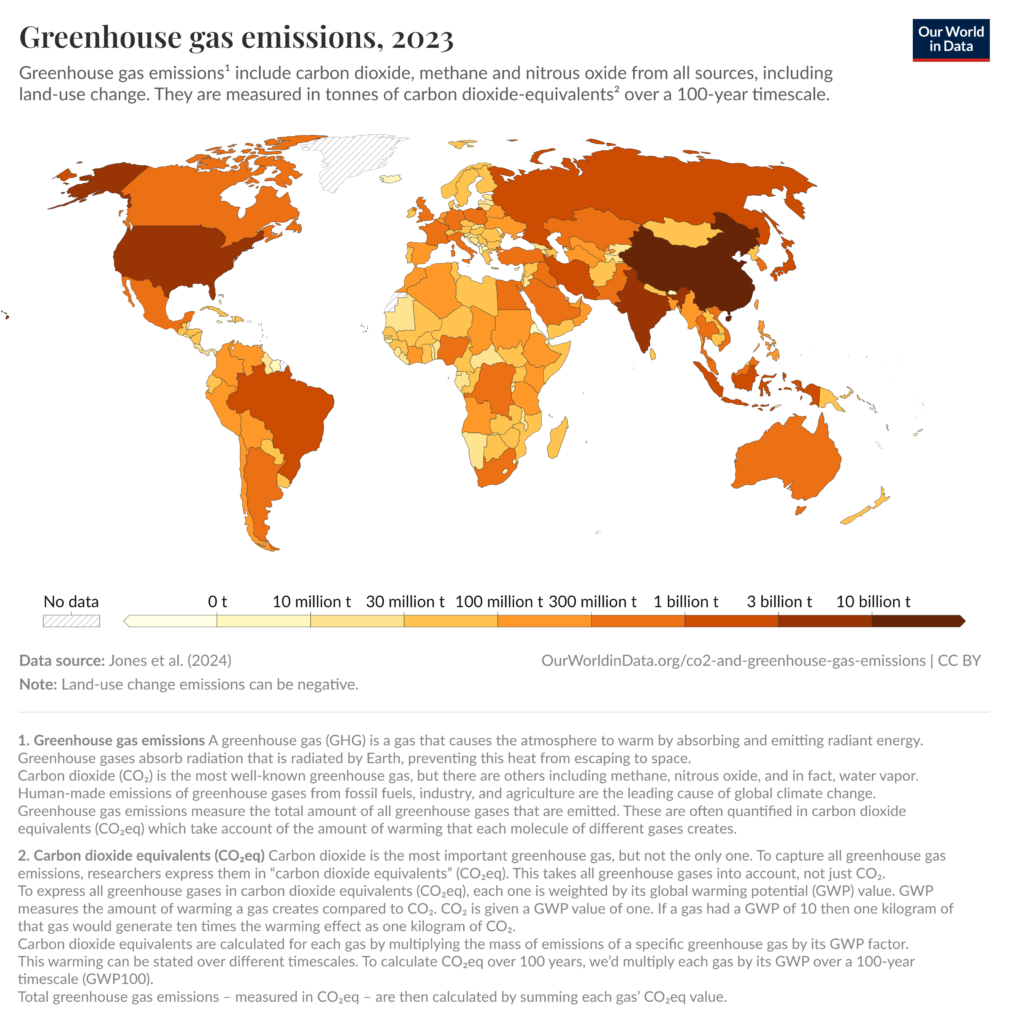
Social impacts
Extreme weather events and droughts caused by climate change are affecting agricultural yields. The consequence is an increase in food prices. Supply chains may also be disrupted. Droughts, floods and food shortages will force people to leave their homes and look for friendlier places. Large-scale climate migrations could lead to social and political unrest.
Economic consequences of high CO2 (carbon dioxide) emissions
The need to adapt to the new climate reality also has economic consequences. The costs of rebuilding disaster-affected areas are enormous. Hurricanes, floods and fires affect increasingly large areas and disrupt infrastructure and entire economic sectors (e.g. agriculture) in addition to destroying human habitats.
Health effects of climate change
Climate change has serious consequences for people. It affects health (increase in disease, heat, pollution), food and water security, causes migration and conflict. It takes a toll on the economy (agriculture, infrastructure) and changes daily life through more frequent extreme weather events. Adaptation and mitigation measures are needed to reduce these risks.
ESG reporting in healthcare and pharmaceuticals
Why does it make sense to reduce greenhouse gas emissions?
In this debate, one question recurs like a boomerang:
- What good will it do if China is emitting more anyway?
- Will our actions really make a difference?
- Maybe it’s better to simply adapt?
Reducing greenhouse gas emissions now, minimises the damage in the future. Every fraction of a degree makes a difference. The difference between a 1.5°C rise and a 2°C rise seems minimal. However, in practice, it means twice as many extreme heat events, and therefore: twice the risk of heat-related deaths. This difference has a huge impact on the risk of water scarcity, as well as climate migration. Even such a small increase in temperature will result in a three times greater risk of loss of coral ecosystems.
One of the most important ways to reduce CO₂ emissions is the energy transition. It also has a real impact on our health. Moving away from burning coal and oil means fewer emissions of particulate matter (PM2.5, PM10), sulphur oxides, nitrogen and mercury, substances that are highly harmful to the body. As a result, the number of cases of asthma or lung cancer may fall. The risk of heart attacks and strokes will also decrease. As a result, this leads to a better quality of life for the elderly and children.
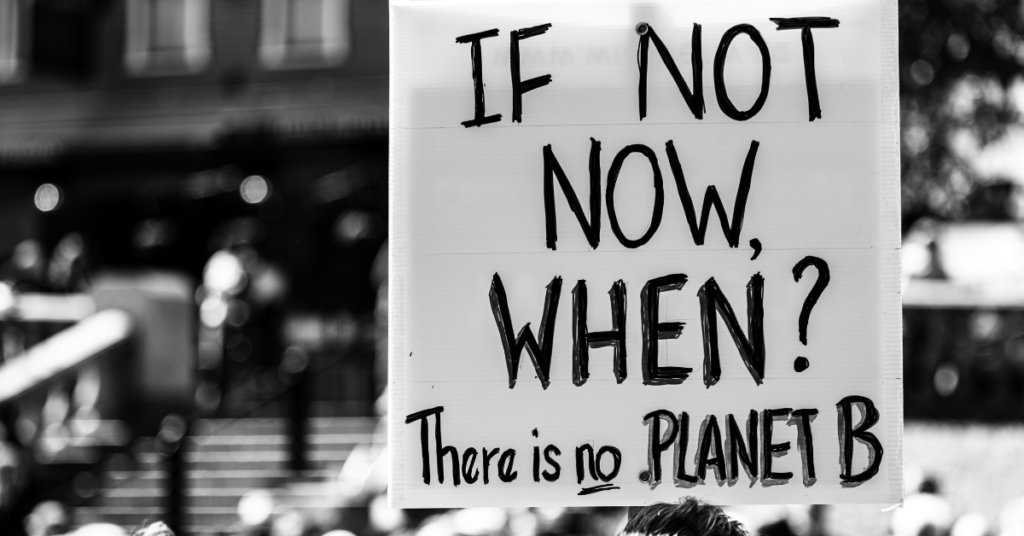
From an economic point of view, it is more advisable to prevent climate change than to fight its effects. Economists from the Stern Review (2006, updated 2021) made it clear: ‘The costs of inaction will be 5-20 times higher than the costs of the energy transition.’
At the moment, RES are already cheaper than fossil fuels. This is not just “green ideology”. It is pure economics. Energy from wind and solar farms is today the cheapest source of electricity in most regions of the world. Since 2010, the cost of solar panels has fallen by more than 80%, batteries by more than 85%. Investments in RES also provide more jobs than the fossil fuel industry.
What can be done?
Climate change is global, but solutions start locally – with everyday choices and public pressure on politicians, companies and institutions. You cannot save the planet alone, but every voice and action matters. Reducing your carbon footprint is possible through the decisions you make every day.
Saving energy
Lights and appliances are worth switching off when not in use. The use of LED bulbs can reduce energy consumption. When buying household appliances and white goods, it is a good idea to pay attention to the energy class – the higher, the better for the climate and the bills.
The source of heat in residential buildings is also important. The use of heat pumps, electric heating based on renewable energy sources (RES) or the selection of a green energy supplier contribute to reducing emissions. In addition, the installation of photovoltaic panels makes it possible to produce one’s own energy. Well-constructed building insulation reduces the need for heating and thus reduces emissions.
Food choices
The production of 1 kg of beef is associated with emissions of approximately 27 kg CO₂. Reducing meat consumption therefore has a real impact on the carbon footprint. Choosing local and seasonal food reduces the emissions associated with transport and storage, as well as gaining access to fresher produce. Planning your food purchases reduces food waste, which also has a positive impact on the climate.
Responsible consumption
A conscious approach to buying goods and services makes a big difference. The “buy less but buy better” principle works best – choosing more durable, reusable products reduces waste. Repairing things instead of throwing them away and using second-hand items (e.g. clothes, furniture or appliances) not only serves the environment, but also the household budget.
Transport
Using public transport, cycling or walking are the most environmentally friendly forms of mobility. In situations requiring the use of a car, it is advisable to choose electric or hybrid models or to share rides. Reducing air travel is also beneficial – one transatlantic flight averages 1 tonne CO₂ per person.
Finance and investments
Where funds are invested is important. It is worth choosing banks and funds that do not invest in fossil fuels and instead support sustainable development. Ethical investment means supporting environmentally responsible companies.
Systemic changes
Systemic solutions are needed to enable sustainable lifestyles without overburdening individuals. Examples include the construction of cycling infrastructure, the development of public transport, energy transition, support for green building and changes in building laws and heating regulations (e.g. coal boilers).
Citizen involvement
The system is also shaped by public pressure. Voting for politicians who take climate issues seriously, participating in local initiatives and supporting environmental organisations all contribute to real change. Companies respond to customer needs and politicians respond to public opinion. Even small actions matter when taken by many people at once. Cultural norms can change faster than we realise.
How achieving climate neutrality for your company helps combat the climate crisis
Education and conversation
The starting point is the climate conversation. Climate education should not only be present in schools and the media, but also in everyday interactions – with family, friends, colleagues. Sharing knowledge and credible sources counteracts misinformation and builds public resistance to the fear of change.
It is not necessary to do everything, but inaction is not the solution. Collective efforts – individual choices, social pressures and political decisions – add up to change on a global scale. Change is possible as long as it is initiated.
Global warming is a fact supported by science
99% of climate scientists are in no doubt: human activity is responsible for the current warming of the climate. This is confirmed by data from atmospheric measurements, satellite analyses and observations from many independent sources around the world.
Knowing that the main cause of climate change is greenhouse gas emissions from human activity, we also hold the key to solving the problem. We can reduce emissions, invest in renewable energy sources, improve energy efficiency and promote sustainable consumption patterns.
Climate change is a challenge, but also an opportunity. Transforming our economies and lifestyles can improve air quality, increase energy security and create new jobs in green sectors. The key to success is cooperation between countries, companies, communities and citizens.
Limiting climate change makes sense – scientifically, economically and morally. Let’s act while we have the choice.
10 facts about climate change
- Climate change and global warming are directly linked to the increasing content of carbon dioxide and other greenhouse gases in the atmosphere, mainly resulting from the burning of fossil fuels.
- In the first half of the 20th century, we began to see a marked rate of temperature increase as a result of the surge in emissions following the industrial revolution.
- Melting glaciers and shrinking ice caps lead to rising groundwater and surface water levels, upsetting the water balance.
- Carbon dioxide and other greenhouse gases affect the Earth’s average surface temperature, amplifying the greenhouse effect and destabilising the climate system.
- Increases in ocean water temperature and changes in land temperature are some of the most visible effects of human activity on a global scale.
- Scientists confirm that human activity, and not just natural factors such as volcanic eruptions or changes in solar radiation, is the main cause of the observed changes.
- In the last decade, climate change has been occurring twice as fast in the Arctic, with huge effects on global sea levels and negative environmental impacts.
- The increase in global temperature and its concentration in the atmosphere is also causing increasing threats to agricultural production, which could greatly affect food security.
- Reducing emissions from energy production and workplace changes such as switching to renewable sources are elements of a needed climate policy, especially within the European Union.
- In the past, some companies ignored the impact of emissions on the Earth’s climate, but today their role in the fight against global warming is crucial.
Sources:
https://www.gov.pl/web/edukacja-ekologiczna/najwieksze-mity-o-zmianach-klimatu
https://climate.ec.europa.eu/climate-change/causes-climate-change_pl
https://climate.ec.europa.eu/climate-change/consequences-climate-change_pl
https://naukaoklimacie.pl/aktualnosci/zrodla-informacji-o-klimacie-12
https://climate.copernicus.eu/copernicus-2024-first-year-exceed-15degc-above-pre-industrial-level
